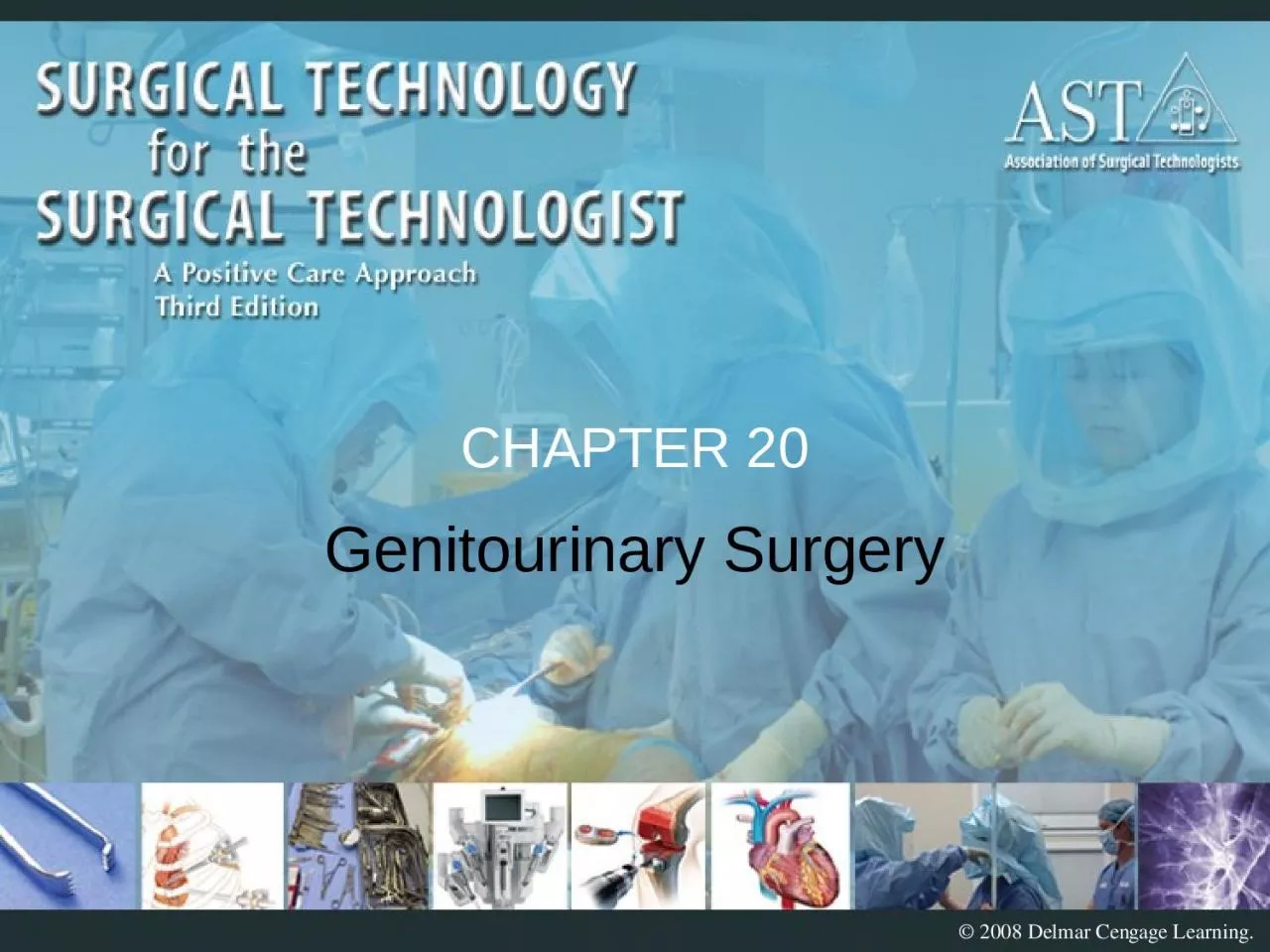

2 Anatomy Suprarenal glands Kidneys Ureters Urinary bladder 3 Supradrenal Glands On top of kidneys Endocrine glands Cortex Secretes steroid type hormones Control fluid and electrolyte balance ID: 931938
Download Presentation The PPT/PDF document "CHAPTER 20 Genitourinary Surgery" is the property of its rightful owner. Permission is granted to download and print the materials on this web site for personal, non-commercial use only, and to display it on your personal computer provided you do not modify the materials and that you retain all copyright notices contained in the materials. By downloading content from our website, you accept the terms of this agreement.
Slide1
CHAPTER 20
Genitourinary Surgery
Slide22
Anatomy
Suprarenal glands
Kidneys
Ureters
Urinary bladder
Slide33
Supradrenal Glands
On top of kidneys
Endocrine glands
Cortex
Secretes steroid- type hormones
Control fluid and electrolyte balance
MedullaSecretes epinephrineNorepinephrine
Slide44
Kidneys
Differ in location and size
Left is normally larger
Nephron is the functional unit
Renal corpuscle
Renal tubule
Filters bloodExcrete waste
Slide55
Ureters
Conduct urine from the kidney to the bladder
Muscular tubes
Small lumen
“S” shaped
Slide66
Kidney/Ureter
Slide77
Urinary Bladder
Collects urine
Lies in the anterior half of the pelvis
Male
Lies on and is attached to the base of the prostate gland
Female
Lies on the pelvic diaphragm
Slide88
Urinary Bladder
Trigone
Ureteral openings
Urethral opening
Base of the bladder
Slide99
Bladder Tumors
Present with hematuria
Single growth or multiple present
Benign (papillomas) occur in young adults
Malignant neoplasms usually occur in men over 50
Early removal transurethrally
Slide1010
Urinary Calculi
Small solid particles
Form in one or both kidneys
Travel through the urinary system
Partial or total obstruction
Slide1111
Urinary Calculi
Calculi symptoms
Dysuria
Polyuria
Passage of small amounts of urine
Flank pain
Nausea and vomiting
Slide1212
Male Reproductive System
Penis
Testes
Ductus
Deferens
Seminal vesicles
Ejaculatory ductsProstate gland
Slide1313
Penis
Superficial structure
Cylindrical masses of cavernous tissue
Two corpora cavernosa
Dorsal
Corpus spongiosum
Midline
Slide1414
Penis
Glans penis
Prepuce
Foreskin
Covers the glans penis
Slide1515
Male Urethra
Passes through the prostate gland
Divided into three parts
Prostatic
Membranous
Spongy
Slide1616
Female Urethra
Only 4 cm long
Passes in front of the lower half of the vagina
Skene’s glands provide lubrication
Slide1717
Testes
Paired
Lie in the scrotum
Tunica vaginalis covers most of the testis, epididymis, and lower end of spermatic cord
Seminiferous tubules
Epididymis
Maturation site
Slide1818
Testis
Slide1919
Ductus Deferens
Arises from the epididymis
Also known as the “vas deferens”
Ascends through the inguinal canal
Delivers semen to the prostatic urethra
Slide2020
Prostate Gland
Accessory gland
Lobulated gland (50 lobules)
Secrete prostatic fluid
Slide2121
Pathology
Adrenal Glands
Cushing’s syndrome
Overproduction of cortisol
Addison’s disease
Complication of certain illnesses – TB and AIDS
Renal insufficiency
Slide2222
Pathology
Adrenal Glands
Pheochromocytoma
Tumor affecting the medulla
Overproduction of adrenaline
Slide2323
Pathology
Urinary System
Bladder tumors
Urinary calculi
Kidney disorders
Slide2424
Kidney Disorders
Polycystic Kidney Disease
Occurs when the parenchyma of the kidney is replaced by multiple fluid filled benign cysts
Autosomal dominant
Inherited
Symptomatic between the age of 30 and 40
90% of PKD fall under this category
Slide2525
Kidney Disorders
Polycystic Kidney Disease
Autosomal recessive
Inherited
Extremely rare
Affects young children
Acquired Develops in patients with long term kidney disease
Slide2626
Kidney Disorders
Diabetic Nephropathy
Sclerosis
Kimmelstiel-Wilson disease
Diabetic glomerulosclerosis
Caused by uncontrolled diabetes mellitus
Slide2727
Kidney Disorders
End-Stage Renal Disease (ESRD)
Kidney failure
Kidneys functioning under 10%
Half the population with ESRD is diabetic
Dialysis
Kidney transplant
Slide2828
Kidney Disorders
Renal Cell Carcinoma
Adenocarcinoma
Most common type of kidney cancer
8,000 deaths per year in the U.S.
Affects men twice as often
Usually appears between 50-60 years oldDirectly linked to cigarette smoking
Slide2929
Kidney Disorders
Congenital Nephroblastoma
Wilms’ tumor
Malignant
Occurs primarily in children between 3-4 years
Surgical removal is recommended
Followed by radiation and chemotherapy
Slide3030
Pathology Affecting
the Male Reproductive System
Phimosis
Hypospadias/Epispadias
Benign Prostatic Hypertrophy (BPH)
Cancer
CryptorchidismTesticular Torsion
Slide3131
Diagnostic Procedures
History and physical
Hematology
Urinalysis
Regular X-ray
KUB (kidney, ureter, bladder)
Slide3232
Diagnostic Procedures
IVU
Retrograde urogram
MIBG
Biopsy
Endoscopy
Slide3333
Special Considerations
Transurethral procedures
Specially equipped room
Built-in table
Radiographic equipment
Darkroom
Drainage system
Slide3434
Special Considerations
General instruments
Kidney instruments
Rib instruments
Slide3535
Cystoscope
Flexible Cystoscope
Rigid Cystoscope
Slide3636
Flexible Ureteroscope
Slide3737
Incisional Options
Inguinal
Access the scrotal contents of an adult or child
Scrotal
Access scrotal contents
Abdominal
Slide3838
Incisional Options
Gibson
Extraperitoneal abdominal approach
Access the lower ureter
Flank
Lumbar
Adrenalectomy, renal biopsy, removal of low lying kidney
Slide3939
Common Procedures
Nephrectomy
Adrenalectomy
Renal transplant
ESWL
Cystectomy
Slide4040
Common Procedures
Marshall-Marchetti-Krantz (MMK)
Circumcision
Orchiopexy
TURP
Prostatectomy
Slide4141
Nephrectomy
Subtotal removal
Upper or lower pole of the kidney
Total removal
Simple
Small malignancies
Chronic obstructive disordersBenign tumorsTransplant
Slide4242
Open Cystotomy
Alternate method of catheterizing the bladder for drainage
Percutaneous
Open
Acute urinary retention
Enlarged prostate
Slide4343
Open Cystotomy
Slide4444
Stress Incontinence in Women
Restore posterior urethrovesical angle
Elevate base of bladder
MMK procedure
Suprapubic suspension
Stamey procedure
Endoscopic suspensionStamey needle
Slide4545
MMK
Slide4646
Stamey Needle Placement